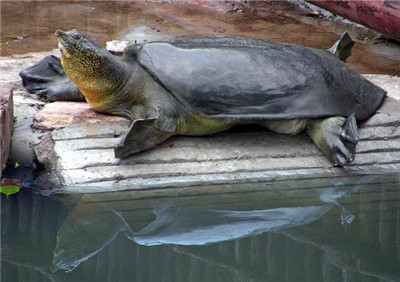(单词翻译:单击)
Earlier this month, an international team of scientists, veterinarians and zookeepers gathered at the Suzhou Zoo near Shanghai. Their desperate mission: to attempt the first artificial insemination ever of a softshell turtle, saving the species from oblivion.
本月早些时候,一个由多国科学家、兽医和动物园管理人员组成的小组齐聚在临近上海的苏州动物园。他们肩负着一项紧迫的使命:首次尝试对一种软壳龟鳖进行人工授精,以防止该物种灭绝。
“Even if we get just one or two hatchlings, I will be very happy,” said Gerald Kuchling, a project leader for the Turtle Survival Alliance, a nonprofit conservation organization. “Even a single one would give hope for the recovery of this magnificent animal. It would be a turn.”
“即使我们只能得到一两只小鳖,我也会非常高兴,”非营利性保护组织龟鳖生存联盟(Turtle Survival Alliance)的项目主管杰拉尔德·库克林(Gerald Kuchling)说。“哪怕只有一只,也能带来让这种奇妙动物的种群数量恢复的希望。这可能是一个转折。”

Quite a turn, actually. The Yangtze giant softshell turtle — thought to be the largest freshwater turtle in the world — was once common in the Yangtze and Red Rivers. But by the late 1990s, pollution, hunting, dams and development had driven it to the brink of extinction.
实际上,的确出现过较大的转折。被认为是全世界最大淡水龟的斑鳖,一度在长江和红河颇为常见。但到了上世纪90年代末,污染、猎杀、水坝和开发,使其陷入了灭绝的边缘。
There are only four known specimens remaining, and only one female — an 85-year-old resident of the Suzhou Zoo. For years, biologists have been trying to coax her and her 100-year-old mate to produce hatchlings. So far the pair have disappointed scientists, with the female laying clutch after clutch of unfertilized eggs.
据研究人员所知,目前世界上仅剩四只斑鳖,其中仅有一只雌性斑鳖,也就是苏州动物园中85岁的这一只。多年来,生物学家一直试图引诱它和100岁的配偶繁衍后代。但迄今为止,这一对斑鳖一直未能让科学家们遂愿。雌斑鳖产下了一窝又一窝未受精的卵。
She was discovered only in 2007, three years after the sole other known female died at the Beijing Zoo. Desperate to find another, Dr. Kuchling and Lu Shunqing, a turtle specialist from the Wildlife Conservation Society’s China branch, had asked every zoo in the country to send them photographs of any large softshell turtles in their possession.
这只雌性斑鳖2007年才被发现。它被发现的三年前,之前那只被认为全世界独一的雌性斑鳖,已在北京动物园死亡。库克林和国际野生生物保护学会(Wildlife Conservation Society)中国分会的龟鳖专家吕顺清渴望再找到一只雌性斑鳖,于是让全国所有动物园都把各自的大型软壳龟鳖的照片寄给他们。
One image, taken at the Changsha Zoo in Hunan, caught their eye, and days later, they arrived to examine the turtle. It was indeed a Yangtze giant softshell turtle and, crucially, a female. She had once been part of a traveling animal exhibition, they learned, and became a permanent resident of the zoo shortly after the end of the Chinese Revolution in 1949.
湖南省长沙动物园拍摄的一幅照片引起了他们的注意。几天后,他们去该动物园对照片上的那只鳖进行了检查。那的确是一只斑鳖,而且关键还是一只雌性斑鳖。他们了解到,那只斑鳖曾经参加过巡回动物展览,在中国革命于1949年结束后不久,它就永久性地留在了该动物园。
Dr. Kuchling and Dr. Lu arranged for her transport to the Suzhou Zoo, where they hoped she and the zoo’s male specimen would begin producing more of their kind. To their delight, the animals did appear to mate, and that summer, the female laid around 180 eggs.
库克林和吕顺清安排将它转移到了苏州动物园,希望它能和那里的一只雄性斑鳖开始繁殖出更多同类。令他们高兴的是,这两只斑鳖似乎的确交配了。那年夏天,雌斑鳖产下了大约180枚蛋。
But none proved fertile, a disappointment that would repeat itself for six years. “The conservation world was holding its breath,” said Rick Hudson, the president of the Turtle Survival Alliance. “It’s been a lot of frustration since.”
但没有一枚受精。这个令人失望的现象重复了六年。“整个野生动物保护界都屏住了呼吸,”龟鳖生存联盟的会长里克·赫德森(Rick Hudson)说,“从那以后就一直失望。”
Scientists decided to intervene. On May 6, Dr. Kuchling and Dr. Lu, with a team that included turtle experts from the United States, drained the male’s pond and used a cargo net to wrangle the 140-pound turtle onto a stack of car tires that served as a makeshift examination stand. Putting him under anesthesia, the scientists used an electrical probe to induce a partial penile erection.
科学家决定插手。5月6日,库克林和吕顺清,以及一个包括来自美国的龟鳖专家在内的小组,抽走了雄斑鳖所在池塘的水,用一个网兜将140磅(约合64公斤)重的它打捞起来,放在堆叠起来充当临时体检台的汽车轮胎之上。将雄龟麻醉后,科学家用一根电探针刺激,让它的生殖器部分勃起。
Normally, the penis of the Yangtze giant softshell turtle looks a bit like a medieval weapon. Equipped with fleshy spikes, protuberances and lobes, it is designed to navigate the female’s equally complex reproductive organ, located inside a byzantine chamber called the cloaca.
斑鳖的阴茎通常看起来有点像一种中世纪的武器。它的阴茎具有肉质刺头、突起和裂片,以便进入雌性斑鳖同样复杂的生殖器官,位于被称为泄殖腔的复杂腔体中。
The problem became immediately clear to the scientists: This turtle’s penis was mangled.
在科学家看来,问题立即变得非常清楚:这只斑鳖的阴茎损坏了。
Two decades earlier, another Yangtze giant softshell turtle had been added to the male’s pond in an attempt to mate the animals. The second turtle turned out to be male, as well, and the two fought. The second male was killed, and the victor suffered serious damage to his shell and, it now appears, to his reproductive organ.
20年前为了促使斑鳖交配,另一只斑鳖被放入了这只雄性斑鳖所在的池塘。结果那只斑鳖也是雄性,两只雄性斑鳖展开争斗。第二只雄性斑鳖死亡,胜者的壳严重受损,现在看来,它的生殖器官当时似乎也受到了损害。
The team also examined the male’s sperm — extracted using electrical stimuli — and finally discovered good news. While motility was low, the sperm were viable. The scientists decided to proceed with artificial insemination of the female.
该小组还通过电刺激提取了这只雄性斑鳖的精子,并对精子进行了检测。最终他们发现了好消息,虽然活性较低,但这些精子具有繁衍能力。科学家决定继续对雌性斑鳖进行人工授精。
With no case studies to go on, the team had to improvise. Dr. Kuchling examined the sedated female’s cloaca with a fiber-optic endoscope to locate the compartment leading to her oviducts. Then Barbara Durrant, the director of reproductive physiology at the San Diego Zoo’s Institute for Conservation Research, deposited the semen.
由于没有案例进行研究,该小组只好随机应变。库克林利用光纤内窥镜对已经麻醉的雌性斑鳖的泄殖腔进行了检查,确定了通往其输卵管的区域所在的位置。圣迭戈动物园(San Diego Zoo)保护研究所(Institute for Conservation Research)生殖生理部门主任芭芭拉·达兰特(Barbara Durrant)注入了这些精子。
“It was just a matter of delivering the semen through a small plastic tube into what we think is the correct place,” she said. “Unfortunately, there just hasn’t been that much basic reproductive physiology work done in turtles and tortoises.”
“就是通过一根小塑料管,将精子送入我们认为正确的地方,”她说。“遗憾的是,龟鳖的基本生殖生理工作以前做得不多。”
Even if it’s guesswork, artificial insemination may be the only chance to save the species. Two other male Yangtze giant softshell turtles are believed to be in Vietnam — one in Hoan Kiem Lake, in the center of Hanoi. But those animals “are pretty much off limits for any non-Vietnamese,” Dr. Kuchling said, and so a collaborative breeding program seems unlikely.
即便只是摸着石头过河,人工受精可能也是拯救这个物种的唯一途径。据信,其他两只雄性斑鳖在越南——其中一只在河内市中心的剑湖。但库克林表示,“非越南人恐怕无法接触到”那些斑鳖,因此不太可能开展合作,实施繁殖计划。
A handful of Yangtze giant softshell turtles may remain in the wild; tentative sightings have been reported in a dam reservoir on the Red River in Yunnan Province. Conservationists, however, are not betting that another male will be captured anytime soon.
还有少量斑鳖可能生活在野外:有人称在云南红河大坝看到过斑鳖。然而保育人士并不确定很快能发现另外一只雄性斑鳖。
Now the wait begins. When the female lays her first clutch of eggs, probably by late June, the scientists will know if this first effort was fruitful.
现在,等待开始了。当雌性斑鳖产出第一批蛋的时候——可能要到6月底,科学家才能知道这第一次的努力是否有效。
“Nobody has ever done this before, and it’s probably a long shot,” Dr. Kuchling said. “But we are all hopeful, and if it doesn’t work this time, we’ll definitely try again. Despair is not an option.”
“以前没人这么做过,成功的希望可能不大,”库克林说。“但我们都充满希望,如果这次不成功,我们肯定会再试一次。我们不会绝望。”


